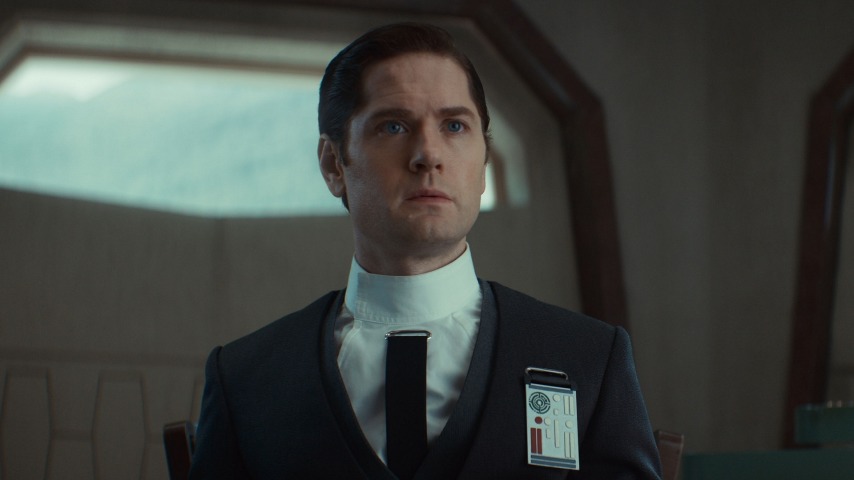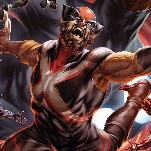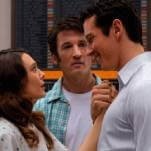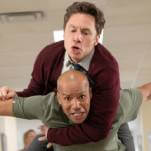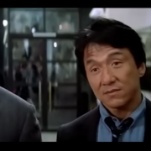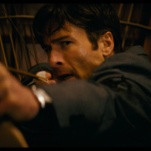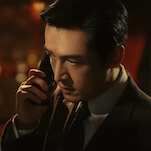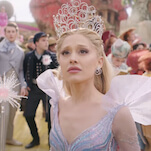It’s a story as old as the history of rebellion—which is to say, as old as politics, violence, and desperation (or, if you want to get cute with the Rogue One call-forwards, hope). A group of people assemble in a public space, united by a furious anger and a litany of injustices. The soldiers are sent to walk amongst them, to bring the rabble to order. Stones are thrown. Tempers rise. Chants become screaming, screaming becomes shoving, blood starts to flow. And then, predictable as the looming sunset, the first shot rings out—both sides, later, will say it was the other—and the bodies begin to fall. And fall. And fall. Of course, the Empire always liked its atrocities to run to a schedule, yes? Easier to have a man in place to ensure the fuse gets lit.
If Andor‘s second season has spent its time, and ours, lavishly on the long game, on the slow and inevitable twisting of the screw, then we’ve come at last to the moment of release. And it feels inevitable that this incredible, awful spectacle, this fantastically gut-churning hour of television, would turn on the shoulders of Syril Karn. It’s embarrassing, really. How am I going to explain, years from now, that my favorite Star Wars character is the dweeby little fascist who let the Galactic Empire break his heart?
It occurs to me, only in the comedown of my first viewing, that this—with the light exceptions of a few quick cuts to Eedy Karn’s apartment back on Coruscant—is the first episode of Andor‘s second season to take place entirely on a single world. We’re here to bear witness to the murder of Ghorman, and there’s no time for Bix’s travails on Yavin or one of Mon Mothma’s signature walk-and-talks. That relentless focus, imposed by Janus Metz’s direction and Dan Gilroy’s script, is central to why this episode works. We’ve spent five episodes watching the trap slowly close on Ghorman, and the show makes the most of the moment when it finally clicks shut and the dying can now begin.
It remains one of the strange paradoxes of Andor that Cassian himself is so often to the side of these big moments: a witness rather than the center of the fight. He observes the tightening of the noose, the raising of patriotic fervor; he watches it all with the eyes of a man who knows how this story ends. (He accurately predicted it one full year ago, in fact.) But he’s largely present to demonstrate that a riot can be a tremendously piss-poor place to try to pull off an assassination, with the chaos obstructing his line on Meero again and again. It’s ironic that the only person who actually has a decent chance of killing her on the day of the (second) Ghorman Massacre is the one who ends up ruining Cass’ own best attempt.
Because the last day of Syril Karn’s life can, if you want to get cute about it, be summed up in a series of three attempted chokings of increasingly ugly severity. The first comes when Carro Rylanz spots him in the crowd headed toward the “miraculously” open Palmo plaza, the elder statesman’s failure to keep his people out of the Empire’s grasp having turned Richard Sammel’s performance Willem-Dafoe-howling-at-the-moon mad. “What kind of a being are you?” he demands of Syril, putting all the sins of the Empire on his goggle-eyed face. “What’s in our ground?” Syril doesn’t know—but even the Empire’s most blinkered fanboy can’t help but start to wonder himself. The second choking is, then, the culmination of the most fascinating acting duo this show has ever produced and one of the most fascinating in all of Star Wars, period. In trying to come to terms with it, I found myself bouncing back to watch Andor‘s first season finale to those moments after Syril saves Dedra from the mob on Ferrix. He’s in awe of her there, grateful to be of use to a mind that can factor all those sharp and awful angles. What a difference three years can make, eh?
This is mostly Kyle Soller’s episode, but Denise Gough is utterly mesmerizing as Syril first grabs, and then starts to choke, Dedra, demanding she tell him what horrors she’s made him a party to. There’s no anger in it on her end, barely even any shock. She is, if anything, more loving than she’s ever been after he releases her, exulting that this is how they get the happy ending she still envisions for them both, by making it easier for the Empire to do what it was always going to do. She fires a verbal jab at him, analyzes his face, tries to find the angle that makes this right. Later, she’ll do something similar to herself, clawing at her collar, grasping at her own hands, desperately trying to force herself back into a shape that can handle both his hatred and his death. She was a fascinating monster before this; god only knows where she goes from here.
In the meantime, the situation in the plaza only escalates, as Metz’s camera captures the rising chaos and the growing body count. Under the disturbingly tranquil eye of Imperial Captain Kaido, first Stormtroopers, and then the deadly KX-series security droids, wade into the fray, killing fighters and fleers alike. (This is probably as good a time as any to raise a minor quibble, by the by: There is something unavoidably goofy about the sound of blaster fire in the aggregate, especially when it’s applied to a scene meant to evoke so much real-world violence; after a while, the pew-pew-pew of it all did start to take me out of the scene a bit.) Cassian, bless his murderous heart, tries one last time to shoot Meero from a distance—which is when the game Andor has been playing for several episodes now, moving Cass and Syril around each other without ever having them intersect, finally pays off.
What does Syril see when he suddenly glimpses the “outside agitator” standing there in the flesh? The arch-Rebel? A man pointing a gun at his ex? Or just the representation of every chaotic element that’s sent his life to hell for the past five years? In any case, Syril attacks Cass with unprecedented violence and furious brutality, the blows landing with sickening impact as he exorcises his demons as directly as possible all over Diego Luna’s face. Even in an episode that’s been a steadily rising wave of violence, it’s a shocking moment, especially when it looks, for all the world, like Syril might win, furiously choking the life out of Cassian before he manages to smash him in the head. A few reversals later, and Syril’s once again got the upper hand, holding the gun on Cassian, who genuinely has no fucking clue where this avenging angel came from. (It’s been at least three years since Ferrix, when Cassian spared some weirdo Rent-A-Cop’s life, against Luthen’s better judgment.) “Who are you?” he asks, as Soller fills up his Emmy submission reel by aggressively failing to answer, his brain trying to find a shape that fits. He starts to drop the gun, perhaps realizing he doesn’t actually have a reason to kill Cass, and—pew: series wrap on Syril Karn.
What follows is at least a little bit lighter, in so far as it involves giant robots getting smashed with trucks and some pretty goofball “Well, we have to assemble the Rogue One crew somehow” bits of canon-welding—at least, until a voice breaks through on the radio, and Andor hammers it all home:
We are under siege. We are being slaughtered. The Imperial murder of Ghorman has begun. There are hundreds of bodies, this moment, as I say this word, hundreds of Ghorman lay dead in Palmo Plaza. Thousands more on the streets. More every minute. We’re being destroyed. This is Ghorman reaching for any open channel that can hear me. If you can hear me, if you believe in truth, if you have any faith left in truth, please, please mark this message, and pass it forward. This is murder! The Empire built this fire. They made this fire and led us to the slaughter. Now they expect us to die without knowing why. Help us! Is there no one who can help us?!
You will, of course, attach your own meaning to this speech and its attendant allegory. Just as you likely did when you heard state reporters repeating propaganda phrases (“imperial norms”) that first slid out of Major Partagaz’s mouth in his ISB back channels, or any of the other ways Tony Gilroy and his team have made Star Wars‘ wars feel neither long ago, nor all too far away. The parallels aren’t subtle, because they aren’t meant to be. They’re bloody and brutal and naked and ugly and exhausting and heartbreaking. But subtle? What would be the point? We’re long past that. It’s part of what makes this one of the finest episodes this finest of Star Wars shows has ever offered up.
Stray observations
- • “You seem…animated.” It’s always fascinating to see and hear how Partagaz manages Meero. “Our struggles with Ghorman are well-documented at this point.”
- • I feel like every episode of this show has some odd little example of what real-world objects look like in the Star Wars universe. Today, I’m fascinated by the Ghorman equivalent of airhorns that some of the protesters carry.
- • “It’s a trap.” The context is so far outside a normal SW crisis that I barely even recognized that Rylanz said the line.
- • Kaido, played by Jonjo O’Neill, is a genuinely scary vision of the blasé nature of Imperial evil. “What I want’s a comfortable ride home. But let’s not confuse the chain of command. I’m the trigger supervisor; you’re the finger.”
- • “Rebellions are built on hope.” Cassian will carry that line forward, to Jyn Erso, who will use it to convince Rogue One to die to secure the Death Star plans. Seeing it emerge here, from hotel clerk/revolutionary Thela, is at least more elegant than “Hey, free robot!”
- • I know they’re taken directly from Rogue One, but the KX droids really are an incredibly effective bit of design—both at rest and then when once they start lumbering through the smoke and fire, leaving bodies in their wake.
- • “We can discuss this later.” “It’s too late already.”
- • Notable touch, especially after all the singing: From the moment the troopers in the crowd shoot back, the soundtrack cuts, leaving nothing but the sounds of screaming and blaster bolts firing.
- • These aren’t action sequences that necessarily get you clapping along with excitement, but it does look cool to see a giant robot cream someone with a kicked barricade.
- • Fantastic sound design in Cassian and Syril’s fight. That “Tang!” when Syril nails him with the chair is a beauty.
- • Dreena’s speech isn’t as polished as some of Andor‘s other bits of rhetoric—she stumbles, she repeats words. But Ella Pellegrini makes a virtue of it, letting the rawness of her emotion shine through.
- • We nearly end on a mirrored shot, Palmo in ruins to contrast the long view of the cityscape we got at the top of the episode. But the Empire must, of course, have the last words: Our final glimpse of the city (and its “Imperial martyrs”) is of the manufactured image, not the reality.
